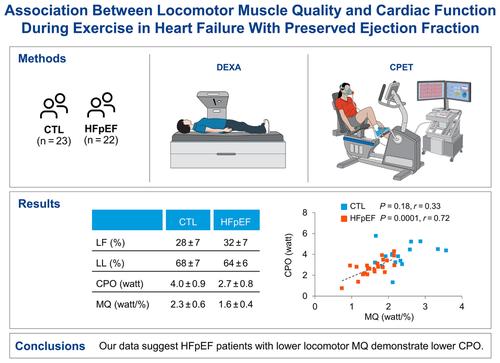当前位置:
X-MOL 学术
›
Eur. J. Heart Fail.
›
论文详情
Our official English website, www.x-mol.net, welcomes your
feedback! (Note: you will need to create a separate account there.)
Association between locomotor muscle quality and cardiac function during exercise in heart failure with preserved ejection fraction
European Journal of Heart Failure ( IF 16.9 ) Pub Date : 2024-11-20 , DOI: 10.1002/ejhf.3528 Salaheddin M. Sharif, Joshua R. Smith, Barry A. Borlaug, Thomas P. Olson
European Journal of Heart Failure ( IF 16.9 ) Pub Date : 2024-11-20 , DOI: 10.1002/ejhf.3528 Salaheddin M. Sharif, Joshua R. Smith, Barry A. Borlaug, Thomas P. Olson

|
AimsMuscle quality (MQ) is used to assess skeletal muscle function; however, the relationship between MQ and cardiac function during exercise in heart failure with preserved ejection fraction (HFpEF) is unknown. Therefore, the study aimed to determine the relationship between locomotor MQ and cardiac function during exercise in HFpEF.Methods and resultsA total of 22 HFpEF patients and 23 healthy matched controls (CTL) were recruited. Body composition including leg lean mass percentage (LL%) was measured by dual‐energy X‐ray absorptiometry. Cardiopulmonary exercise testing was performed and peak oxygen uptake (VO2 ) was measured. Cardiac output (CO) was measured via the open‐circuit acetylene wash‐in technique, heart rate by electrocardiogram, and cardiac power output (CPO) was calculated. Blood pressure was measured manually and mean arterial pressure (MAP) was calculated. MQ was calculated as peak watts divided by LL%. LL% was significantly lower in HFpEF than in CTL (p < 0.05). At peak exercise, workload, VO2 , CO, and CPO were significantly lower in HFpEF (p < 0.05 for all). MQ was significantly lower in HFpEF than in CTL (1.6 ± 0.4 vs. 2.3 ± 0.6 W/%, p < 0.0001). MQ was positively correlated with CO (r = 0.51), CPO (r = 0.72) and MAP (r = 0.64) in HFpEF (p < 0.05 for all) but not in CTL.ConclusionOur data suggest MQ is closely related to cardiac function at peak exercise in HFpEF. These data suggest that MQ may be a useful tool for understanding exercise performance in HFpEF.
中文翻译:

射血分数保留的心力衰竭运动时运动肌质量与心脏功能的关系
AimsMuscle quality (MQ) 用于评估骨骼肌功能;然而,射血分数保留的心力衰竭 (HFpEF) 患者运动期间 MQ 与心脏功能之间的关系尚不清楚。因此,该研究旨在确定 HFpEF 运动期间运动 MQ 与心脏功能之间的关系。方法和结果共招募了 22 例 HFpEF 患者和 23 例健康匹配对照 (CTL)。通过双能 X 射线吸收测定法测量包括腿部瘦体重百分比 (LL%) 在内的身体成分。进行心肺运动试验并测量峰值摄氧量 (VO2)。通过开路乙炔冲洗技术测量心输出量 (CO),通过心电图测量心率,并计算心功率输出量 (CPO)。手动测量血压并计算平均动脉压 (MAP)。MQ 的计算方法是峰值瓦特除以 LL%。HFpEF 的 LL% 显著低于 CTL (p < 0.05)。在运动高峰期,HFpEF 的工作量、VO2、CO 和 CPO 显着降低 (p < 0.05)。HFpEF 的 MQ 显着低于 CTL (1.6 ± 0.4 vs. 2.3 ± 0.6 W/%,p < 0.0001)。MQ 与 HFpEF 中的 CO (r = 0.51)、CPO (r = 0.72) 和 MAP (r = 0.64) 呈正相关 (p < 0.05),但在 CTL 中不呈正相关。结论我们的数据表明,MQ 与 HFpEF 运动高峰期的心脏功能密切相关。这些数据表明,MQ 可能是了解 HFpEF 运动表现的有用工具。
更新日期:2024-11-20
中文翻译:

射血分数保留的心力衰竭运动时运动肌质量与心脏功能的关系
AimsMuscle quality (MQ) 用于评估骨骼肌功能;然而,射血分数保留的心力衰竭 (HFpEF) 患者运动期间 MQ 与心脏功能之间的关系尚不清楚。因此,该研究旨在确定 HFpEF 运动期间运动 MQ 与心脏功能之间的关系。方法和结果共招募了 22 例 HFpEF 患者和 23 例健康匹配对照 (CTL)。通过双能 X 射线吸收测定法测量包括腿部瘦体重百分比 (LL%) 在内的身体成分。进行心肺运动试验并测量峰值摄氧量 (VO2)。通过开路乙炔冲洗技术测量心输出量 (CO),通过心电图测量心率,并计算心功率输出量 (CPO)。手动测量血压并计算平均动脉压 (MAP)。MQ 的计算方法是峰值瓦特除以 LL%。HFpEF 的 LL% 显著低于 CTL (p < 0.05)。在运动高峰期,HFpEF 的工作量、VO2、CO 和 CPO 显着降低 (p < 0.05)。HFpEF 的 MQ 显着低于 CTL (1.6 ± 0.4 vs. 2.3 ± 0.6 W/%,p < 0.0001)。MQ 与 HFpEF 中的 CO (r = 0.51)、CPO (r = 0.72) 和 MAP (r = 0.64) 呈正相关 (p < 0.05),但在 CTL 中不呈正相关。结论我们的数据表明,MQ 与 HFpEF 运动高峰期的心脏功能密切相关。这些数据表明,MQ 可能是了解 HFpEF 运动表现的有用工具。

































 京公网安备 11010802027423号
京公网安备 11010802027423号